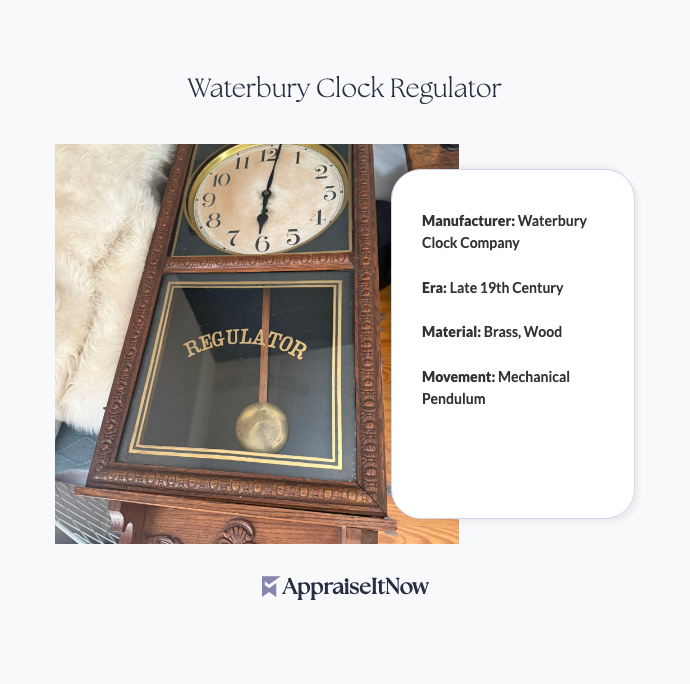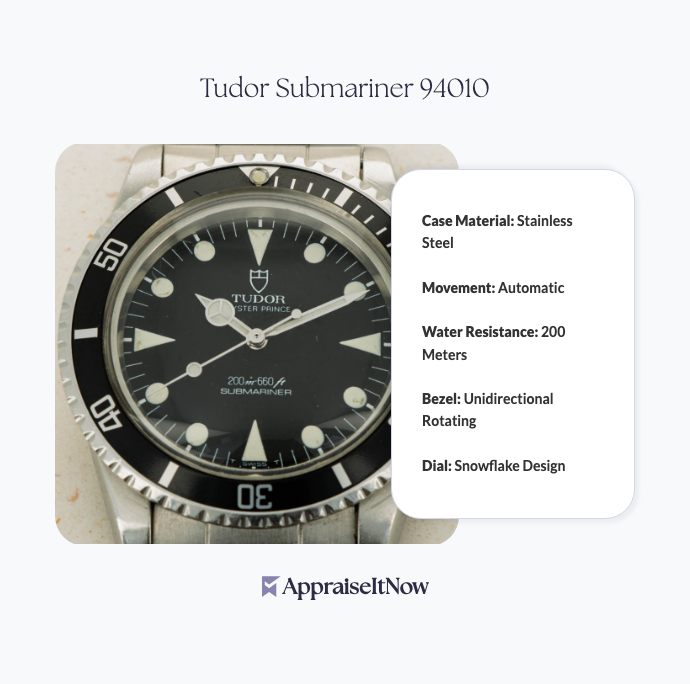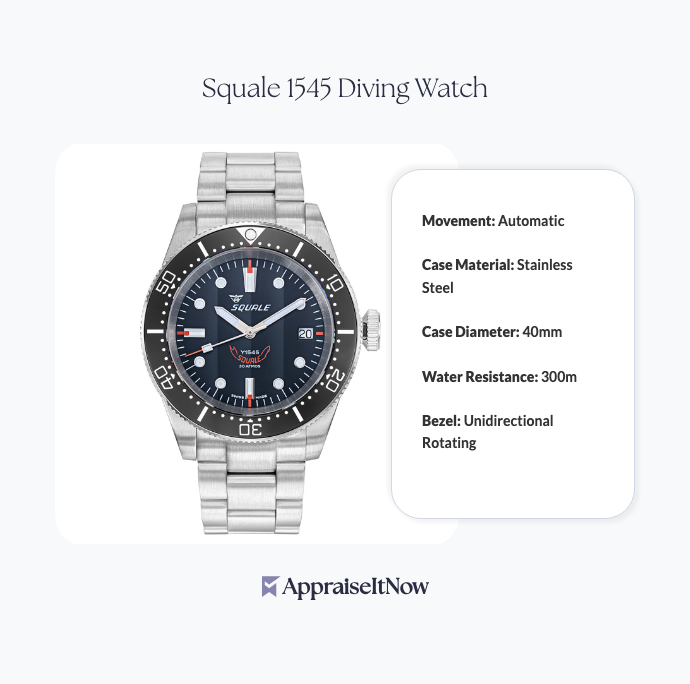<h1>How to Get Your Waterbury Clock Regulator Appraised</h1>
<p>The Waterbury Clock Regulator stands as a remarkable piece of American horological craftsmanship, commanding collector interest and significant monetary value in today's antique market. If you own one of these precision timepieces—or are considering acquiring one—understanding how to properly appraise a Waterbury Clock Regulator ensures you have accurate documentation for buying, selling, insurance, or estate planning purposes.</p>
<h2>What Makes Waterbury Clock Regulators Valuable</h2>
<p>Your Waterbury Clock Regulator represents more than just a functional timepiece; it embodies precision engineering and historical significance from Connecticut's golden age of clockmaking. Manufactured by the <strong>Waterbury Clock Company</strong> beginning in the 1860s, these regulators were engineered specifically for professional environments where accurate timekeeping was mission-critical. Today, examples in good condition typically command <strong>$600 to $900</strong> in the collector market, with exceptional specimens commanding premium prices.</p>
<p>The distinction between a standard clock and a regulator matters considerably when determining value. A regulator clock represents a specialized precision instrument designed to maintain accuracy within narrow tolerances—quite different from ornamental household timepieces. The Waterbury design incorporated a brass pendulum and weight system, distinctive wooden casework, and mechanical precision that collectors recognize as superior to competing American manufacturers of that era.</p>
<div class="callout tip"><p><strong>Collector's Insight</strong></p>
<p>Waterbury Clock Regulators with original hardware, unmolested movements, and documented provenance consistently achieve the higher end of the valuation range.</p></div>
<h2>Understanding Age and Dating Your Waterbury Clock Regulator</h2>
<p>One of the first questions when evaluating any antique clock involves determining its exact age. How do you tell the age of a Waterbury clock? The company's production spanning from the 1860s through the early 20th century created multiple generational versions, each with distinct stylistic and mechanical characteristics. While determining how old a clock needs to be to qualify as vintage (typically 20-40 years) versus antique (generally 50+ years) involves industry standards, your Waterbury's actual manufacturing date significantly impacts its appraised value.</p>
<p>Waterbury clocks from the 1920s era frequently raise the question of whether they're classified as vintage or antique. Industry standards generally recognize items from the 1920s as antique, given we're now well over a century from that production period. However, the specific decade of manufacture creates distinct value differences—earlier regulators from the 1860s-1890s command premiums over later Victorian or early 20th-century examples.</p>
<p>To date your regulator accurately, examine the movement for maker's marks, patent dates stamped on the mechanism, and style indicators like case construction methods. The brass pendulum design and weight system can reveal manufacturing era through design evolution. Professional appraisers possess the specialized knowledge to pinpoint production dates with precision, often identifying within a decade-or-less window.</p>
<h2>Key Specifications That Affect Appraisal Value</h2>
<p>The specifications of your Waterbury Clock Regulator directly influence its professional appraisal. These precision instruments featured meticulous craftsmanship that collectors recognize and value appropriately. Your regulator likely incorporates the company's signature brass pendulum and weight systems, ornate wooden casework, and the mechanical precision that earned Waterbury clocks their reputation for reliable timekeeping in offices, schools, and institutions.</p>
<p>The question of how you date a regulator clock extends beyond manufacturing date to understanding original specifications versus modifications. Original components—particularly the brass pendulum, weights, and mechanical movement—preserve value far more effectively than replaced parts. Any restoration work, while potentially improving aesthetics, may actually reduce value among serious collectors who prefer originality and authenticity.</p>
<p>When considering whether it's okay to move clock hands backwards, collectors and conservators emphasize that mechanical intervention on antique regulators can damage delicate escapements and gear systems. This conservation principle underscores why originality matters so significantly in appraisals—any evidence of amateur adjustment or modification typically reduces appraised value.</p>
<h2>Finding Out What Your Clock Is Worth</h2>
<p>How do I find out what my clock is worth? Professional appraisal services like <strong>AppraiseItNow</strong> specialize in precisely this valuation challenge, offering tech-enabled platforms where you can submit photographs, detailed descriptions, and documentation to credentialed appraisers. Rather than relying on guesswork or free online estimates, certified appraisers with expertise in <a href="/types/antique-furniture">antique furniture</a>, <a href="/types/memorabilia-and-collectibles">memorabilia and collectibles</a>, and period timepieces provide USPAP-compliant valuations accepted by insurance companies, auction houses, and legal institutions.</p>
<p>The process typically involves examining your clock's condition, movement quality, original hardware retention, case integrity, and any documented provenance or ownership history. Professional appraisers photograph multiple angles, document any maker's marks or patent dates, and research comparable sales to establish fair market value. This documentation proves invaluable whether you're seeking insurance coverage, planning estate distribution, or preparing for auction.</p>
<p>Finding the value of antiques for free through online databases provides limited accuracy for specialized items like Waterbury regulators. While general price guides offer reference points, they cannot account for condition variables, originality factors, or regional market fluctuations that certified appraisers evaluate systematically.</p>
<h2>Insurance and Documentation Considerations</h2>
<p>Your Waterbury Clock Regulator likely represents one of your more valuable collectibles, making proper insurance documentation essential. Appraisals provide the certified valuations that insurance companies require for appropriate coverage levels. Unlike standard homeowners policies that often include blanket coverage limits for collectibles (typically $500-$1,500), valuable regulators benefit from scheduled personal property riders backed by professional appraisals.</p>
<p>When seeking an appraisal for insurance purposes, request specifically that the report be formatted for insurance company submission. Certified appraisers understand the documentation requirements that underwriters need, including detailed condition assessments, high-resolution photographs, and comparable market analysis supporting the valuation conclusion.</p>
<p>The question of whether people are still buying grandfather clocks and similar mechanical timepieces applies equally to Waterbury regulators—the collector market remains robust for quality examples. Institutional buyers including decorative arts museums, historic sites, and private collectors actively seek well-documented regulators, particularly those with interesting provenance or exceptional condition.</p>
<h2>Exploring Resources for Antique Clock Appraisals</h2>
<p>Understanding what appraisers look for when evaluating antique timepieces helps you prepare your clock appropriately for professional assessment. Our comprehensive guides on <a href="/blog/appraising-antiques-unveiling-the-hidden-treasures-in-your-collection">appraising antiques</a> and <a href="/blog/finding-a-qualified-appraiser-for-antique-artwork">choosing qualified appraisers for antique artwork</a> offer detailed insights into the evaluation process. For specialized guidance, exploring <a href="/blog/how-to-accurately-determine-the-value-of-your-memorabilia-and-collectibles">how to accurately determine memorabilia and collectibles value</a> provides additional context for understanding what drives market pricing.</p>
<p>Additionally, our blog on <a href="/blog/unraveling-the-mysteries-of-antique-appraisals-a-guide-for-collectors">understanding the mysteries of antique appraisals</a> addresses common questions collectors have about the appraisal process, documentation requirements, and how professional valuations enhance collection management and decision-making.</p>
<div class="callout note"><p><strong>Key Takeaway</strong></p>
<p>A certified appraisal of your Waterbury Clock Regulator provides accurate, defensible valuation documentation that protects your financial interests whether buying, selling, insuring, or estate planning. Professional appraisers bring specialized knowledge of this specific manufacturer's variations, market dynamics, and condition assessment that ensure your clock receives appropriate recognition for its historical significance and monetary value.</p></div>







.avif)







